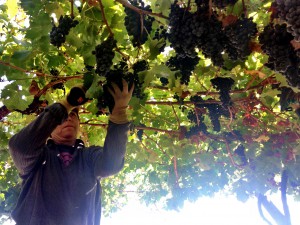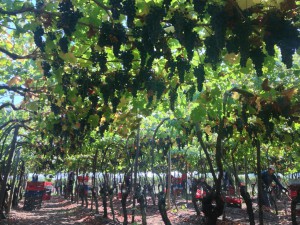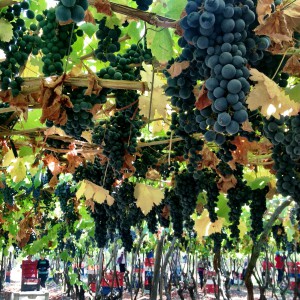2017 Chilean Wine Harvest Update
2017 Chilean Harvest:
2017 was a fantastic growing season up until the other day. As many of you might have heard on the news massive fires broke out in Chile. The fires have been a devastating blow to the Chilean people. However, The Curico Valley and the Southern regions of Colchagua Valleys were thankfully not affected. Unfortunately other Chilean wine growing regions such as the Maipo Valley were greatly affected by the fires and might not be able to produce vintages this year. We encourage everyone to donate to the Red Cross to aid in the relief of these fires.
The growing season for the Curico and Colchagua Valley’s was a hot and dry one. Expect wines with great character, intense flavors, complexity, and distinction. We should be receiving grapes around the same time as last year, maybe a little earlier for the whites. The first white grapes will be picked at the end of February. Carmenere will be in shorter supply this year as the demand has gone up for this grape, so put your orders in early!
The wines of Chile – along with the winemakers and vineyards that produce them – have had some profound transformations in the past 30 years. Grape growers have successfully determined which varietals thrive in their vineyards, have experimented with unique trellising systems, and explored interesting new areas for planting. The wines now have a head start because of the wonderful grape quality.
Musto Wine Grape Company, LLC. has been importing quality Chilean wine grapes for over 10 years. We have developed long lasting relationships in Chile and are constantly growing and developing the program. The vineyards are located between the Andes Mountains and Pacific Ocean. Therefore, the vines have excellent growing conditions for perfect ripeness and complexity thanks to the ocean breeze and Mediterranean climate.
The Curico Valley has been a wine grape growing region since the 1800’s and is located about 115 miles south of Santiago in the Central Zone of Chile. It is known as the “Heart of the Chilean wine industry”. Curico has the perfect fertile soil and is best known for its micro climates and the ability to grow over 30 different wine grape varieties. Situated along the Guaiquillo River and nestled between mountains on its east and west sides, Curico’s Mediterranean climate and unique topographical features helps to create some of the finest wine grapes in South America.
The climate in the valley is characterized by morning fog and wide day-night temperature fluctuations. Climatic conditions in some parts of the valley favor wines with higher acidity, such as white varieties including Chardonnay, Sauvignon Blanc, Vert and Gris. High quality Cabernet Sauvignon, Syrah, Merlot, and Carménère grapes are sourced from warmer areas of the valley, such as Lontué, particularly when produced from ancient vines.
Terroir: Sandy, clay, decomposed granite, volcanic-alluvial
Grape Varieties Available: Cabernet Sauvignon, Cabernet Franc, Carmenere, Malbec, Merlot, Petite Verdot, Pinot Noir, Syrah, Chardonnay, Pinot Gris, Sauvignon Blanc, Viognier
Juice Varieties Available: Cabernet Sauvignon, Cabernet Franc, Cabernet-Merlot Blend, Carmenere, Malbec, Merlot, Petite Verdot, Pinot Noir, Syrah, Chardonnay, Pinot Gris, Sauvignon Blanc, Viognier, Muscat
The Winemaker’s Think Tank: Vol 2 – What do I need to get started making wine with fresh juice?
The Winemaker’s Think Tank?
Every Thursday we will post about a few frequently asked questions that our winemaker has answered. If you have a winemaking question you would like to have answered, please email us at support@juicegrape.com and we will try to get into next week’s post. Cheers! 🙂
What do I need to get started making wine with fresh juice?
When elevating your winemaking to the next level, often sourcing the best ingredients is the most direct path to better results. After getting great base experience using wine kits, the next logical step to wine making greatness is fresh juice. When making this change from wine kits to fresh juice, other ingredients may be needed to ensure the juice will reach its greatest potential as wine. First, evaluate your juice for acid (pH) and sugar (Brix). What are the levels present in your juice? If the Brix level is below 20, you may consider adding sugar to increase the Brix levels to 24-26. What is the pH of the wine? Juice should have a pH greater than 3.1 to ensure a successful fermentation. If the pH is higher than 3.8, consider adding tartaric acid. This will ensure a better tasting wine after fermentation as well as a more stable wine.
The next area to consider is yeast. Certain strains of yeast will amplify certain traits within the finished product of wine such as fruit character, spice notes, or floral notes. The yeast has certain parameters that it will ferment best within, so consult a winemaking expert at Musto Wine Grape to help you select the best yeast strain for your wine. The yeast is the important catalyst that will process the grape juice into wine. The yeast will need certain nutrients to best assist it with its fermentation such as a rehydration nutrient like Go Ferm, and subsequent nutrients to finish out the fermentation process such as Fermaid O and Fermaid K. Musto Wine Grape stocks yeast along with all of the aforementioned nutrients in small packages, designed for the individual buckets of juice. This will give you perfectly measured amounts of products to add to your wine, making proper fermentation simple and with no wasted/unused product.
We hope this information helps with your winemaking. If you have any follow up questions or winemaking questions in general, please email us at support@juicegrape.com.












Recent Comments